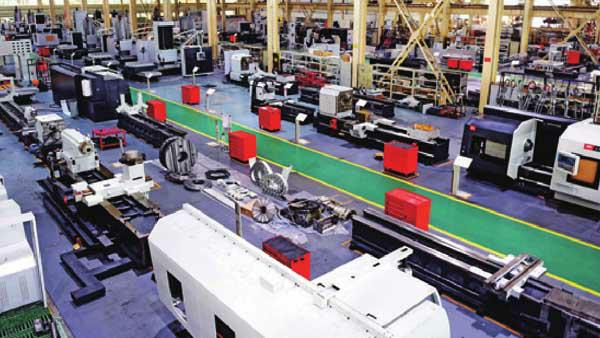Buffing The Northeast
2016-12-26ByLiNan
By+Li+Nan
The sluggish economic performance of the northeastern region in the first three quarters of 2016 has once again sounded alarms for the Chinese Government. The region—encompassing the three provinces of Liaoning, Jilin and Heilongjiang—used to be the countrys industrial heartland before the 1990s. But its development has lost steam in recent years as a result of Chinas attempts to shift its economic engine away from a reliance on manufacturing and infrastructure investment toward services and consumption-based growth.
The latest data from the National Bureau of Statistics suggest that the economic growth rate of the three provinces has been relatively low. Liaonings GDP shrank 2.2 percent year on year in the first nine months, making it the only provincial-level region to record contraction so far this year. Heilongjiangs GDP rose 6 percent from a year ago, lower than the national growth rate of 6.7 percent. Only Jilins economy expanded faster than the national average, with a year-on-year growth of 6.9 percent .
“Northeast Chinas economy is already at the bottom,” said Zhou Jianping, head of the Northeast China Revitalization Department of the National Development and Reform Commission (NDRC).
Zhou made the remark on November 17 at a press conference one day after the NDRC rolled out a guideline—the third this year—seeking to revive the region. In April, the NDRC released a framework document to revive northeast China. In August, a followup implementation plan was unveiled.
The November guideline comprises 14 new moves which aim to revitalize the northeastern region. Among them, piloting the mixedownership reform of state-owned enterprises(SOEs), implementing the Made in China 2025 industrial transformation plan, setting up a private bank and building a new free trade zone(FTZ) are high on the agenda.
New growth drivers
One of the first things that will occur is the reshuffling of the ownership of up to 60 SOEs. “In 2014, SOEs encompassed half the total assets of northeastern industrial enterprises with annual sales revenue above 20 million yuan ($2.89 million)—that is five times the national average figure,” wrote Chi Fulin, Director of the China(Hainan) Institute for Reform and Development, in a recent article. “If SOEs are not the first to be reformed, the plan to revive northeast China would be beset by difficulties.”
The guideline encourages SOEs to transform and upgrade themselves by undergoing industrial reorganization and to set up capital investment arms to preserve and increase their value.
Furthermore, private capital is welcomed in efforts to reform SOE ownership. A batch of public-private partnership projects is to be launched to attract private capital.
Northeastern enterprises are urged to develop intelligent, green and service-oriented manufacturing according to the Made in China 2025 plan, thereby gaining a better position to move into the international market. Made in China 2025 is the countrys first 10-year blueprint which aims to boost manufacturing capability. The plan, released by the Central Government in May 2015, drew inspiration from Germanys Industry 4.0 scheme which emphasizes the use of information technology—such as the Internet of Things—in manufacturing.
To that end, some new industrial parks are to be opened in the region with the help of the countrys leading SOEs. From November 21 to 23, the NDRC invited a group of senior managers from six industrial parks such as Beijings Zhongguancun Science Park and Tianjins Binhai New Area to visit northeast China and share their experiences with more than 6,000 local officials and company staff.
But some fear that the SOE reform may kill jobs in the region. “There will be layoffs stemming from the reform,” Fu Cheng, head of the Institute of Sociology, Jilin Academy of Social Sciences, told Beijing Review. But he said massive layoffs are unlikely to happen. “The government has several ways to decelerate job cuts,” he said, adding that relocations and retraining could be offered.
Northeast Chinas private sector has long been dwarfed by SOEs, Chi said. Only nine enterprises from the region made the ranking of the countrys top 500 private companies published by the All-China Federation of Industry and Commerce in August, compared with 134 from east Chinas Zhejiang Province.
“Financial support for the real economy in northeast China has been insufficient in recent years,” said Wen Bin, the chief researcher of the China Minsheng Bank, at the 2016 Forum on Reviving Northeast China held in Harbin, capital city of Heilongjiang, on August 20.
Private banks can not only offer more loans to local small and medium-sized enterprises, but also provide new investment channels for private capital, according to Wen. He suggested more private banks be set up there to diversify the local banking system and to spur the real economy.
In August, China approved the establishment of seven new FTZs including one in Dalian—Liaonings gateway port city facing South Korea and Japan. The guideline says the FTZ will pool together shipping, logistics and equipment-manufacturing businesses.
What sets the Liaoning FTZ apart from other similar initiatives is that it is expected to pilot major reform measures to boost the cross-border flow of human resources, goods, information and capital, thus helping northeast China improve its market economy system, according to Zhang Wanqiang, head of the Institute of Economics, Liaoning Academy of Social Sciences.
Lingering problems
The recent guideline primarily focuses on “concrete issues” and is “feasible in the near future,”which will help to ease the downward economic pressure on northeast China, claimed Zhou.
Yet some warn that there is a long way to go before the region recovers momentum.
In fact, the Chinese Government has been endeavoring to revive the northeast since 2003. In 2004, the NDRC approved 60 projects with a total investment of 5.6 billion yuan ($682 million) to develop high-end technology industries in the region. And in the past decade, there have been at least 11 central government documents demonstrating preferential policies for the region. Still the outcome of the decade-long-effort has been less than satisfactory. Why?
The lack of targeted, effective policies and follow-up measures partly account for the phenomenon, Fu said. “Preferential policies concerning northeast China are not‘concrete enough, compared with those in the southeastern coastal regions,” Fu told Beijing Review. The northeast, as a region which had missed the first opportunities for reform and opening up, does not need policies transplanted from other regions, he said. Rather, a unique and effective strategy to attract capital is required.
Another possible explanation is the shortage of people savvy about the rules of the market economy, especially outstanding entrepreneurs. Northeast China has suffered from a 1-million drain in its workforce in the last decade—most of them elites, at the management level or part of the backbone of production lines, said Zhou.
“Therefore, despite the preferential policies available, locals lack the finesse needed to carry them out,” said Fu.
He believes that raising the average remuneration rate is the only solution to retain innovative professionals as incomes in northeast China are low compared with other regions.
Last but not least, funds are deficient. “Funds earmarked by the Central Government and preferential policies are both needed to spur northeast Chinas development. Its unfair for the region, which contributed greatly to the national economy over the past decades, to have to solve its current problems by itself,” he said.
